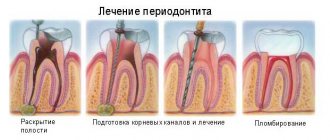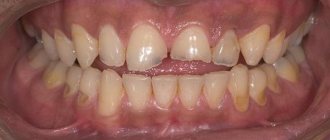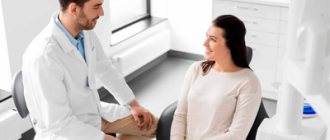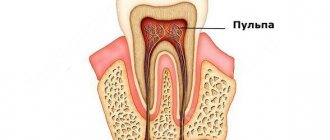Walking in the fresh air is useful at any time of the year, but still a long stay outside in sub-zero temperatures can sometimes unexpectedly lead to local hypothermia of the face and head. Often the consequence is an inflammatory process in the dental nerve.
In such cases, patients usually say that they “have caught a cold on the dental nerve.” Experts call this phenomenon “local hypothermia of the dental nerve.”
Inflammation in this case usually has nothing to do with the penetration of infection. The reason is directly related to the experience of severe hypothermia.
To understand the reason for the development of inflammation in the dental nerve after exposure to cold temperatures, you should first pay attention to the anatomy. The center of the tooth is the pulp.
The pulp is a soft tissue with its own system of blood vessels and nerves. It has a loose structure. Each pulp tissue performs a specific function. It is known that large nerves of the pulp have a connection with the root processes. If toothache occurs, it is always associated with the dental nerve in the pulp.
What to do if the nerve in the tooth has caught a cold - symptoms, treatment and prevention
After a long stay in the cold, your tooth may ache. In this case, aching pain with twitching usually occurs - this is a direct sign of a cold nerve. If your teeth are in perfect order, they should not give any reaction to temperature changes. But if there is a pathological process, including a hidden one, it can worsen as a result of hypothermia. Further in this article we will talk about what to do if the nerve of the tooth has caught a cold, and how to quickly get rid of toothache and prevent the development of complications.
Inflammation of the gums due to gingivitis and periodontitis –
With gingivitis, the patient complains of swelling, redness or cyanosis of the gingival margin and interdental gingival papillae, bleeding and soreness of the gums when brushing teeth, and bad breath (Fig. 1-2). The development of gingivitis is associated with a microbial factor, i.e. when, against the background of not very good oral hygiene, soft microbial plaque accumulates in the area of the necks of the teeth and hard tartar forms.
Pathogenic bacteria from soft microbial plaque and hard tartar produce toxins and inflammatory mediators, which cause inflammation in the gums. Please note that with gingivitis, inflammation affects only the gingival margin and is not accompanied by destruction of the periodontal attachment or bone tissue around the teeth. But if at this stage the causative factor of inflammation (microbial plaque and tartar) is not removed, then over time the destruction of the dentogingival attachment, the bone tissue around the teeth, as well as the periodontal attachment of the roots of the teeth to the bone occurs. All this already indicates the transformation of gingivitis into “chronic periodontitis”.
Inflammation of the gums (chronic periodontitis) –
Periodontitis is still characterized by all of the above symptoms of gingivitis + over time, tooth mobility appears, during periods of exacerbations, purulent discharge may be released from under the gums, the roots of teeth gradually become exposed, and also in severe stages of periodontitis, fan-shaped divergence of teeth occurs (Fig. .5-6).
Inflammation of the gums: treatment for gingivitis and periodontitis
If the patient complains of generalized inflammation of the gums, treatment for gingivitis and periodontitis begins with the procedure for removing dental plaque, and immediately after this a course of anti-inflammatory therapy is prescribed. Bacterial plaque and tartar can only be removed from teeth by a dentist, and usually ultrasonic teeth cleaning is used for this (Fig. 7-8). However, the course of anti-inflammatory therapy itself can be carried out at home, and for this, the dentist will prescribe you a course of antiseptic rinses and gel applications to the gums.
Ultrasound removal of dental plaque: photo
ANTI-INFLAMMATORY THERAPY SCHEME:
Let's now see how to treat gum inflammation with medication, and first of all, antiseptic rinses and gel applications to the gums will help us with this. But you must understand that if you decide to neglect the stage of removing dental plaque at the dentist and start with drug therapy, this will only temporarily suppress the symptoms, but will not stop the destruction of the attachment of the gums to the teeth (which will simply be more asymptomatic).
1) Antiseptic rinses - drug treatment of gum inflammation usually lasts - 7-8 days for gingivitis and 10 days for periodontitis. We will need an antiseptic solution for rinsing the mouth (usually chlorhexidine is prescribed), as well as an anti-inflammatory gel for the gums. Gum treatment is carried out 2 times a day (morning and evening), and it is important to do it only after meals and subsequent oral hygiene. And precisely in this sequence, and not vice versa!
Thus, in the morning you should have breakfast, brush your teeth and then rinse your mouth with an antiseptic chlorhexidine solution. To do this, you must take 10 ml of solution into your mouth (about 1 sip) and, without spitting, rinse your mouth for a full 1 minute. Next, spit out the solution and under no circumstances rinse your mouth with water! An important issue is the effective concentrations of chlorhexidine, and you can read more about this at this link (this article provides reasoning and links to clinical studies).
With gingivitis, everything is quite simple, and if you have removed plaque from your teeth at the dentist, then, in principle, the usual inexpensive solution of 0.05% chlorhexidine, which is sold in any pharmacy for 30-40 rubles, will be more or less effective (although it is considered optimal to use at least 0.12% chlorhexidine). But if we are talking about periodontitis, then the minimum effective concentration should be at least 0.2%. Products containing 0.2-0.25% chlorhexidine are more expensive, for example, Parodontax Extra mouthwash with 0.2% chlorhexidine will cost from 210 rubles per 300 ml bottle.
2) Application of gel to the gums - immediately after rinsing, we need to apply a special anti-inflammatory gel to the gums. The best medicine for gum inflammation for these purposes is Cholisal gel, which copes with inflammation very quickly, but it costs about 470 rubles (per tube of 15 g). At the same time, you will need 1 tube for the course of treatment of gingivitis, and 2 tubes of the drug for the course of treatment of periodontitis. If this is expensive, then you can use Parodontocid gel, which is certainly weaker than Cholisal, but it will work well if you combine it with 0.2% chlorhexidine.
Gels Cholisal and Parodontocid:
The gel is applied to the gingival margin around the necks of the teeth and interdental gingival papillae using the tip of the index finger. First, it is advisable to apply the gel around the lower teeth, then around the upper ones (note that the gel must be applied not only from the front surface of the teeth, but also from the palate/tongue). The gel will adhere better to the moist mucous membrane if you first dry the gingival margin with a dry gauze swab. It is better to treat the gingival margin from the front surface of the teeth in 2 stages (24stoma.ru).
Those. First, you rub small portions of the gel into the gum margin (using light massaging movements), after which you apply the gel without massage and leave it on the gum. The gel can be applied to the gingival margin from the palate/tongue only once, rubbing small portions of the gel with light massaging movements. Another option for applying the gel is using a thin medical (dental) spatula or applicator. After applying the gel, it is advisable not to drink for at least 30 minutes, and you should not rinse your mouth or eat food for at least 2-3 hours.
Important: during the application of the gel, saliva may be actively released, but it does not need to be accumulated in the mouth or spat out. Saliva should be swallowed as you usually do. In the evening, repeat the treatment in the same sequence (dinner → oral hygiene → antiseptic rinse → applying gel to the gums). And you should do this for 7-8 or 10 days, depending on the type of gum inflammation.
Important:
- With gingivitis, only the marginal part of the gum is affected by inflammation, so the above-mentioned anti-inflammatory course and preliminary removal of dental plaque is quite sufficient to completely stop the inflammation in the gums.
But to prevent inflammation from occurring again, it is very important to maintain proper oral hygiene. Below at the link you can read comprehensive information on the forms of gingivitis and their treatment - → Algorithm for the treatment of gingivitis - For periodontitis , i.e.
when the symptoms of gingivitis are accompanied by tooth mobility, exposure of roots, suppuration from periodontal pockets - just removing dental plaque and the above course of anti-inflammatory therapy will no longer be enough. This may additionally require antibiotic therapy, washing of periodontal pockets, splinting of mobile groups of teeth, as well as surgical treatment methods. Read more about this in the article – → Algorithm for the treatment of periodontitis
Where is the nerve located in the tooth?
The visible part of the tooth is called the crown - it is covered on top by a layer of enamel, under which there is dentin. Below it is a central part filled with pulp. We are talking about a neurovascular bundle located in the cavity and passing into the internal structures of the root system. The pulp is penetrated by many nerves and vessels. In this case, the number of nerves corresponds to the number of roots. The largest nerves are directly connected to the root processes, while the small ones are concentrated in the pulp chamber.
The photo shows the structure of the tooth
When acute painful sensations occur in a tooth, most often this indicates the development of a pathological process in the pulp. A natural consequence of nerve inflammation is pathologies such as pulpitis and periodontitis. In the initial stages of the disease, there is always a chance to save the pulp and the tooth itself. If the pathology is too advanced, depulpation (pulp extraction) or even tooth extraction may be required.
Causes of trigeminal neuralgia
Trigeminal neuralgia occurs due to various reasons, among which the following are common:
- Compression (squeezing) of the trigeminal nerve by vessels or neoplasms.
- Pathologies of the nervous system (multiple sclerosis, meningitis).
- Malocclusion.
- Inflammatory pathologies of the nasal sinuses.
- Injuries.
- Hypothermia.
- Viral or bacterial infections of the upper respiratory tract.
Damage to the trigeminal nerve after tooth extraction
There is also trigeminal neuralgia of odontogenic origin. In this case, the pathology is caused by diseases of the teeth, jaws or oral cavity. Sometimes such complications arise after tooth extraction.
You can suspect damage to the facial nerve after tooth extraction if pain occurs in the eye area, temporal area or nose. In this case, the trigger for pain is harmless procedures or events, for example, a gust of wind or brushing your teeth.
Important! Don't be afraid to have teeth removed when it is medically necessary. Damage to the facial nerve during tooth extraction is extremely rare. But complications in the absence of proper dental treatment occur much more often. Therefore, it is important to trust an experienced doctor, with whom the likelihood of complications is minimized.
There are two main reasons why the trigeminal nerve is damaged due to tooth extraction:
- Diagnostic error . Sometimes neuralgia is so successfully disguised as a toothache that the doctor makes an erroneous diagnosis. Instead of treating trigeminal neuralgia, the patient is treated or the tooth is removed. At the same time, the pain intensifies.
- Difficulties in dental treatment . Sometimes, when treating severe stages of pulpitis, the nerve is often injured, which causes neuralgic symptoms.
Complication after implantation
Among the complications encountered in implant dentistry is damage to the trigeminal nerve. In this case, the nerve fibers are affected mechanically (during the procedure), due to the inflammatory process or against the background of an infectious complication.
Damage to the trigeminal nerve during implantation can occur at various stages of the procedure, starting with anesthesia. Careful diagnostics using computed tomography, as well as surgical templates, will minimize the risks of complications in implantology.
Complications from the trigeminal nerve also occur with an incorrectly selected implant, when the risk of injury to nerve fibers increases. Increased pressure on the implant during installation is also fraught with damage to the trigeminal nerve.
Important! According to statistics, the likelihood of complications from the trigeminal nerve during implantation is less than 3%. At the Center of Israeli Dentistry this figure is even lower. In this case, an experienced team of doctors and careful preparation for the implantation procedure can minimize the likelihood of complications. Therefore, our patients do not need to worry about the consequences.
What is the true cause of nerve inflammation
Various factors lead to inflammation of the neurovascular bundle. Among the most common causes of the development of a pathological condition, experts in the field of endodontics identify the following phenomena:
- advanced untreated caries, turning into pulpitis,
- injuries, chips, fractures,
- poor quality treatment leading to relapse of the disease,
- filling using low-quality composites and medications,
- medical errors made during the treatment of the crown before prosthetics,
- other dental diseases accompanied by infection of dental tissues.
Pulpitis can cause inflammation.
As for whether it is possible to catch a tooth nerve, too much exposure to the cold can indeed provoke acute symptoms of inflammation. In such cases, they usually say that the tooth is blown or caught a cold. But in fact, an acute reaction is only a consequence of already existing problems, and the cold is only a kind of trigger.
How to recognize the problem - characteristic symptoms
With inflammatory processes in the pulp, symptoms inevitably arise, and they are very intense, so it is quite difficult not to notice them. The most common signs of a problem include the following:
- aching, increasing pain, which can be localized both in the tooth itself and in the jawbone area, radiating to the ear or eye,
- often the pain becomes shooting in nature,
- increased sensitivity of the enamel appears, acute reactions occur to cold, hot, spicy and sour, any mechanical irritants,
- Sensitivity may also extend to the eye and forehead area,
- discomfort appears while eating, talking, or when trying to smile.
One of the symptoms is aching, increasing pain in the tooth or in the entire jaw.
The root cause of the problem is always the pathological phenomena already present in the tooth. When pathogenic microorganisms penetrate the pulp, acute pain of a pulsating nature occurs. It becomes especially strong at night. In such a situation, a sudden change in temperature or prolonged exposure to the cold provokes acute symptoms. When the nerve is inflamed, pulpitis is usually diagnosed, but if the inflammation extends beyond the pulp, periostitis (flux) or periodontitis may develop, including the formation of purulent neoplasms.
Symptoms of the disease
Symptoms of the pathology include:
- Severe pain in the face . Often the pain syndrome covers the area of the upper and lower jaw. Often this type of pain misleads a person, masquerading as toothache. However, after dental treatment the pain does not go away.
- Facial muscle spasms and changes in skin sensitivity . The spasms cause the person to have difficulty communicating or chewing.
- Facial asymmetry . In particular, the asymmetry is clearly visible when talking or smiling.
- Shooting pain attacks.
Concomitant symptoms of trigeminal neuralgia include increased salivation, insomnia, anxiety, changes in taste, local or general increase in body temperature.
What to do if your nerve gets cold
Regarding what to do if there are obvious signs of nerve inflammation and how to quickly relieve severe pain, experts suggest first carrying out antibacterial treatment of oral tissues in order to prevent the further spread of the pathological process. This can be done by rinsing your mouth with Chlorhexidine or, say, a soda-saline solution.
Gargling with a soda-salt solution will help relieve acute pain.
Next, it is imperative to relieve the pain, but in no case should you apply heat to the cheek from the side of the causative element - this will only intensify the acute symptoms and provoke an even greater spread of inflammation. Read on to find out how best to act in such a situation.
Emergency help
If the tooth hurts very badly, before visiting the doctor you need to at least muffle the symptom a little, and in this case you can take a painkiller tablet: “Ketanov” or, for example, “Nalgesin Forte”. For urgent help, you can resort to external agents with an anesthetic effect. These include the drugs “Lidocaine”, “Kamistad gel”.
Drug therapy
If signs of inflammation appear, the first thing to do is immediately go to the doctor. After a visual examination and assessment of the current condition of the causative tooth, the doctor will definitely send you for an x-ray. Having all the necessary data in hand, the specialist will choose a further vector of treatment: conservative therapy, depulpation or even complete removal.
If the doctor chooses a conservative direction, in this case it will be necessary to open the crown, treat the pulp and administer an antibiotic. After a few days, the acute inflammation should subside - then the patient will be sent for a repeat X-ray. If everything is normal, the doctor will place a permanent filling and prescribe appropriate medications. In such situations, painkillers, antiseptic rinses, and special medicinal pastes are usually prescribed. If the case is advanced, the drug "Amoxiclav" or "Ciprofloxacin"1 may be prescribed.
The photo shows the canal treatment scheme
Surgical intervention is resorted to in the last stages of the pathological process - with the development of pulpitis and periodontitis. To ensure that all foci of inflammation are eliminated, the tooth must be depulped, the canals treated and filled. In this case, a tooth without a nerve, in theory, can no longer hurt, although in practice there are relapses of the symptom after removal of the pulp. This happens when the root canals are treated insufficiently, in which pockets of inflammation remain, if fragments of pulp remain in the canals, or if the pathological process has led to the formation of neoplasms in the root area. In all these cases, urgent assistance from a specialist is required.
What does traditional medicine offer?
If acute symptoms develop, you should definitely visit the dentist, and it is better to do this as soon as possible. Only a doctor can choose an adequate treatment that will be effective and at the same time safe. As a maintenance therapy, the use of traditional medicine recipes is allowed, but only after their agreement with a specialist. Below are popular recipes:
- alcohol tincture with birch buds: to prepare the product, you need to take 25 g of raw materials and pour a glass of alcohol into it. Mix the ingredients thoroughly and leave in a cool, dark place for a week and a half. After this time, the solution will be ready for use - just dip a cotton swab into it and then apply it to the affected area,
Birch bud tincture is used in folk medicine - chicory: approximately one tablespoon of chicory should be diluted in a glass of boiling water, then left for several hours to allow the product to infuse. You can then rinse your mouth with it as needed.
- sage: dilute a few spoons in boiling water (one glass). After this, the broth should be left until it cools completely. The product can be used at intervals of 30 minutes until the condition normalizes,
- decoction of willow bark: pour 5 teaspoons of crushed willow root into a glass and pour hot boiled water. Afterwards, cool and use as intended, after diluting a little with warm water.
“Once in the winter I caught a toothache, and such an unpleasant nagging pain appeared. By evening it got worse. I remembered my grandmother’s old recipe - add a piece of lard. You won't believe it, but it worked! The next day, of course, I run to the dentist. It turned out to be caries, which is why the tooth gave such a reaction to the cold. But the lard saved me, I don’t know how, but it’s a fact.”
Olchik, from correspondence on the forum www.32top.ru
Remember: traditional medicine will help only in symptomatic therapy and only as support for the main treatment. With their help, it is impossible to eradicate the disease, and even if all the symptoms disappear, this will not eliminate the need to visit the dentist.
What to do is strictly contraindicated
We have figured out how and with what to treat an inflamed nerve, and now let’s move on to the question of what absolutely cannot be done if the neurovascular bundle is damaged. With this clinical picture, the pain can be very severe, and not all painkillers and anti-inflammatory solutions can relieve the disturbing symptom. Relying on self-medication in such a situation is strictly contraindicated. Even if you manage to relieve the discomfort, the pathology will continue to spread and destroy the internal structures of the tooth, which will ultimately lead to the need for its removal.
Under no circumstances should you apply a heating pad to an inflamed nerve.
You cannot self-prescribe antibiotics or any other medications, or use traditional medicine without first talking to your doctor. Also, you should not apply a heating pad to the sore spot - heat will only intensify the pain and provoke further spread of inflammatory processes.
Preventive measures
Most often, the true cause of the problem is advanced caries, when the lesion penetrates deeper into the internal structures of the tooth and captures the nerve. As a result, any mechanical or temperature effect provokes severe pain, and sometimes can even aggravate the situation with complications. If the tooth is completely healthy, it is almost impossible to develop hypothermia due to prolonged exposure to low temperatures.
Preventative dental examinations will help avoid problems.
To protect yourself from problems with dental nerves, you need to treat any dental diseases in a timely manner. Better yet, do everything possible to prevent their development. In this regard, experts strongly recommend adhering to basic hygiene rules: brushing your teeth at least twice a day, using mouth rinses and visiting the dentist at least twice a year - for prevention and prophylaxis. hygiene. Conscientious implementation of these simple rules will help protect against most dental problems, including pulpitis, periostitis and periodontitis.
- Zoryan E.V., Rabinovich S.A., Matveeva E.G. Algorithm for choosing local anesthetic drugs, problems and solutions, 2008.
Preventive measures
To prevent the patient from catching a dental cold, disease prevention plays an important role.
- Clothing must be appropriate for the time of year and weather conditions. Don't forget to wear a scarf and a warm hat. If discomfort occurs, return to a warm room.
- The best preventative measure is systematic dental examinations. Caries should not be allowed to progress so that the integrity of the tissues is not compromised.
- The teeth brushing procedure must be correct. Food debris is removed with floss, and the oral cavity is rinsed with special solutions.
- Don't indulge in sweets.
- You need to beware of cold winds even in the warm season.










